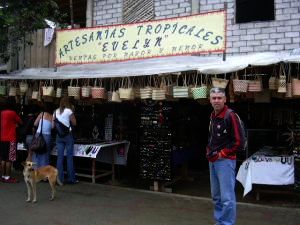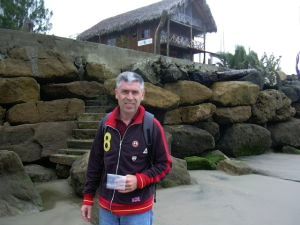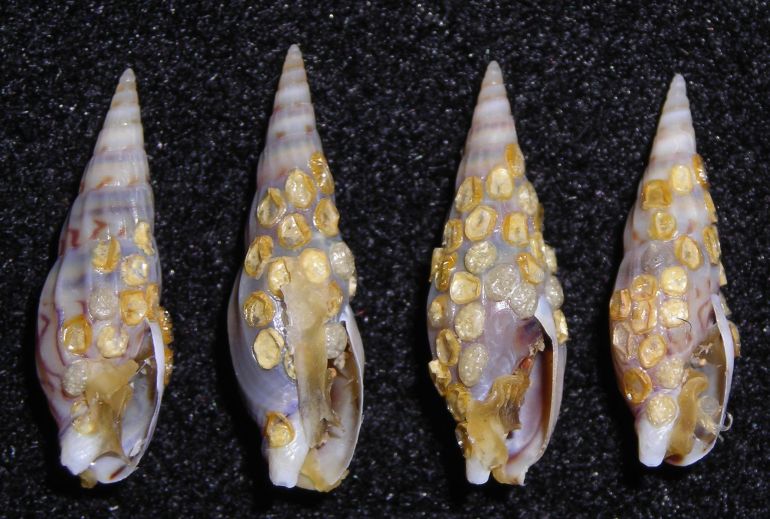
numero unico anno 2006
 |
page 089 |
page 091 |
 |
Mazatlania fulgurata Philippi, 1846
Susanna Zanelli e Raffaele Petrone
Luglio 2004: Ecuador centro meridionale – Regione ad ovest di Guayaquil – MontanitaArriviamo la mattina verso le ore otto nel piccolo villaggio di pescatori ancora addormentato. Incontriamo solo un gruppetto di giovani americani, in pantaloncini corti e infradito, dai capelli spettinati con un andatura barcollante dovuta probabilmente ai bagordi di una notte insonne.Il clima non ci assiste (la stagione non è certo l’ideale per andare in Ecuador); siamo avvolti da una leggera nebbiolina che lascia una inequivocabile sensazione di bagnato sui nostri abiti rigorosamente estivi. La temperatura si aggira attorno ai 22° C. Davanti a noi la strada principale che conduce direttamente alla fermata dove ci ha lasciato il pullman di linea per il mare. Data l’intensità delle onde del Pacifico ne riusciamo tranquillamente a sentire il fragore. Saranno appena 150 metri da percorrere a piedi, fra due file di casette, a due piani con bar, ristoranti e negozietti per turisti, che hanno preso il posto delle vecchie abitazioni dei pescatori. Naturalmente la strada non è asfaltata, ormai ci abbiamo fatto l’abitudine da queste parti.  L’Oceano Pacifico ci appare nella sua impetuosità appena superato un piccolo dosso artificiale. Il paradiso dei surfisti (così è conosciuto il villaggio in Ecuador) attira turisti da tutte le parti del mondo –soprattutto dal nord America – ma sembra che il momento migliore della giornata per “prendere le onde” sia il primo pomeriggio. Ora dormono ancora tutti e le onde, sebbene grandi, non ci sembrano molto adatte a lunghe cavalcate. Meglio così, pensiamo noi, con la spiaggia libera potremo dedicarci tranquillamemnte alle nostre ricerche. Anzi ci rendiamo conto che il mare stesso si è ritirato di qualche metro, con la bassa marea, lasciandoci una piacevole sorpresa: le onde si infrangono sulla spiaggia, continuano la loro corsa giungendo a lambire i nostri piedi e, tornando indietro, lasciano scoperte migliaia di piccole conchiglie che, rapidamente si infossano sotto la sabbia, fine e scura, che si estende per qualche centinaio di metri verso nord. Che colpo di fortuna! Non potevamo sperare di meglio! Sull’onda dell’entusiasmo raccogliamo alcuni esemplari per capire con precisione di cosa si tratti. Ci sono alcune specie di Olive: l’Oliva undatella Lamarck, 1810 e l’Olivella columellaris (Sowerby, 1825) ma restiamo maggiormente colpiti da un’altra conchiglia. All’inizio, con grande meraviglia, crediamo di esserci imbattuti in una strana Terebra ma ... dopo ricerche più approfondite ci rendiamo conto che si tratta di una Columbella, la Mazatlania fulgurata descritta per la prima volta da Philippi nel 1846 e localizzata tra Mazatlan, in Messico, e il Nicaragua. Noi ci troviamo in Ecuador, ben più a sud, quindi, questa columbella si trova su un’area più estesa. Per quanto riguarda il nostro primo errore di classificazione non siamo stati i primi a compierlo, tant’è vero che Gould nel 1853 la chiamò Terebra arguta. Un altro sininimo conosciuto è stato dato da Autori sconosciuti ed è un probabile errore di spelling: Eurita fulgurans.
L’Oceano Pacifico ci appare nella sua impetuosità appena superato un piccolo dosso artificiale. Il paradiso dei surfisti (così è conosciuto il villaggio in Ecuador) attira turisti da tutte le parti del mondo –soprattutto dal nord America – ma sembra che il momento migliore della giornata per “prendere le onde” sia il primo pomeriggio. Ora dormono ancora tutti e le onde, sebbene grandi, non ci sembrano molto adatte a lunghe cavalcate. Meglio così, pensiamo noi, con la spiaggia libera potremo dedicarci tranquillamemnte alle nostre ricerche. Anzi ci rendiamo conto che il mare stesso si è ritirato di qualche metro, con la bassa marea, lasciandoci una piacevole sorpresa: le onde si infrangono sulla spiaggia, continuano la loro corsa giungendo a lambire i nostri piedi e, tornando indietro, lasciano scoperte migliaia di piccole conchiglie che, rapidamente si infossano sotto la sabbia, fine e scura, che si estende per qualche centinaio di metri verso nord. Che colpo di fortuna! Non potevamo sperare di meglio! Sull’onda dell’entusiasmo raccogliamo alcuni esemplari per capire con precisione di cosa si tratti. Ci sono alcune specie di Olive: l’Oliva undatella Lamarck, 1810 e l’Olivella columellaris (Sowerby, 1825) ma restiamo maggiormente colpiti da un’altra conchiglia. All’inizio, con grande meraviglia, crediamo di esserci imbattuti in una strana Terebra ma ... dopo ricerche più approfondite ci rendiamo conto che si tratta di una Columbella, la Mazatlania fulgurata descritta per la prima volta da Philippi nel 1846 e localizzata tra Mazatlan, in Messico, e il Nicaragua. Noi ci troviamo in Ecuador, ben più a sud, quindi, questa columbella si trova su un’area più estesa. Per quanto riguarda il nostro primo errore di classificazione non siamo stati i primi a compierlo, tant’è vero che Gould nel 1853 la chiamò Terebra arguta. Un altro sininimo conosciuto è stato dato da Autori sconosciuti ed è un probabile errore di spelling: Eurita fulgurans.Due particolari ci colpiscono immediatamente: la colorazione estremamente variabile, come si può vedere dalla foto di pag. 093 (almeno sedici gradazioni di colore diverso), e delle pustule gelatinose attaccate su molte conchiglie da noi raccolte. Con uno studio più approfondito abbiamo scoperto trattarsi di capsule ovigere, ben evidenziate nella foto sottostante anche se non più fresche, che l’animale fissa sul proprio guscio aumentando fortemente le probabilità di sopravvivenza dei veliger. Questo rende la specie molto prolifica e adatta a riprodursi con molta facilità e in grandi quantità. |
July 2004: Southern Central Ecuador – Region to West of Guayaquil - MontanitaWe arrived there at about eight o’clock in the morning. The little fishing village was still asleep. We met only group of young Americans in shorts and slip-slops and with disarrayed hair, swaying as they walked, due most probably to the revelry of a night without sleep. The climate didn’t help much - it was most certainly not the best season of the year to go to Ecuador. We were wrapped in a light mist that left one with the unmistakable sensation of dampness on our strictly summer clothes. The temperature had got to about 22° C. Before us lay the main street that led directly to the bus stop where the ocean-front bus line had dropped us off. Given the intensity of the waves of the Pacific, we were easily able to hear the roar of the ocean. We had to walk for almost 150 metres between the two lines of small double-storied houses where bars, restaurants and shops for the tourists had taken the place of the old fishermen’s houses. Naturally the street was not tarred but we had by now become accustomed to this in these parts. With all its impetuousness, the Pacific Ocean seemed to have barely gotten over a small artificial rise. The surfers’ paradise (as the village is known in Ecuador), attracts tourist from all over the world - and especially from North America – but it seemed that the best moment of the day to “take to the waves” was in the early afternoon. Everyone was still asleep and the waves, big though they were, did not seem very suited to long rides. Better so we thought, as with the beach empty and free of people, we could dedicate ourselves peaceably to our research. Still better, we noticed that the sea had drawn back a few metres with the low tide, leaving us a pleasant surprise: the waves breaking on the beach, continued their course to lap at our feet and in ebbing, left thousands of little shells which rapidly buried themselves in the fine dark sand that extended for some hundreds of metres northwards. What a stoke of luck! We couldn’t have hoped for better! Carried on a wave of enthusiasm, we collected some
specimens so as to understand what they were. There were some species of
Oliva: Oliva undatella Lamarck, 1810 and Olivella columellaris (Sowerby,
1825) but we were struck by yet another shell. We marveled at the beginning,
believing ourselves to have run across a strange Terebra but.........
after further research we realized that it was a Columbella, the Mazatlanian
fulgurata described for the first time by Philippi in 1846 and localized
between Mazatlan, in Mexico and Nicaragua. We were in Ecuador - much
further South. So this Columbella was to be found over a more extensive area.
In reference to our first classification error, it would seem that we were not
the first to make such an error, for in 1853 Gould called this same
Columbella, Tenebra arguta. Another known synonym was given by some
unknown Authors and was in all probability due to a spelling error: Eurita
fulgurans. Carried on a wave of enthusiasm, we collected some
specimens so as to understand what they were. There were some species of
Oliva: Oliva undatella Lamarck, 1810 and Olivella columellaris (Sowerby,
1825) but we were struck by yet another shell. We marveled at the beginning,
believing ourselves to have run across a strange Terebra but.........
after further research we realized that it was a Columbella, the Mazatlanian
fulgurata described for the first time by Philippi in 1846 and localized
between Mazatlan, in Mexico and Nicaragua. We were in Ecuador - much
further South. So this Columbella was to be found over a more extensive area.
In reference to our first classification error, it would seem that we were not
the first to make such an error, for in 1853 Gould called this same
Columbella, Tenebra arguta. Another known synonym was given by some
unknown Authors and was in all probability due to a spelling error: Eurita
fulgurans.
|

